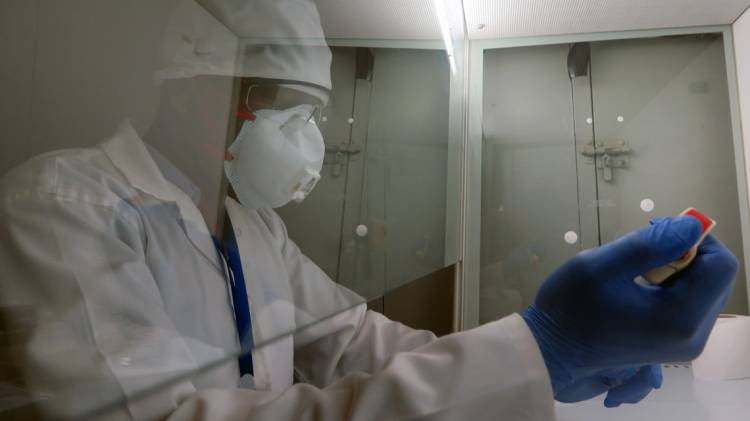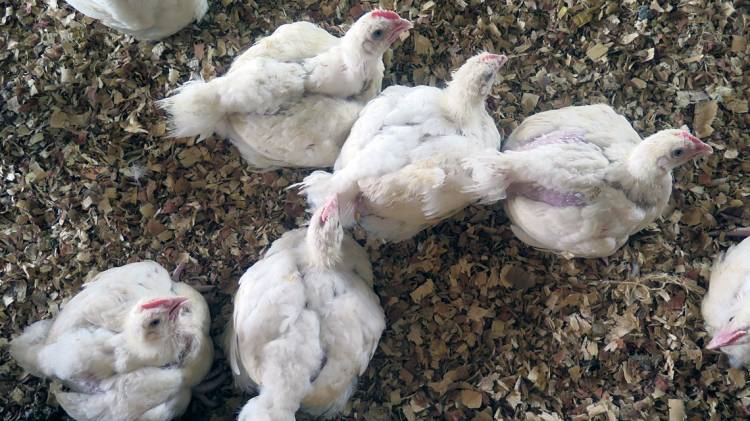How To Stop The Spread Of Ebola From Animal To Human
Yaoundé, Republic of cameroon and Bangui, Cardinal African Republic — An brute as tiny equally a bat tin bear upward to 137 different virus species. Many of these, including Ebola, can be transmitted to humans. After years of studying bats and other animals in the jungles of central Africa, scientists are joining forces nether IAEA projects to prevent the spread of diseases that tin can be transmitted from animals to humans, known as zoonotic diseases.
"Effectually 75% of man diseases originate from animals, which is why it is so important to stop them at the animal level," said Abel Wade, Managing director of the National Veterinary Laboratory in Yaoundé, Cameroon. "Nuclear-derived engineering helps us exercise this."
During the Ebola epidemic of 2014, the IAEA speedily reacted to provide specialized diagnostic equipment to help Sierra Leone in its efforts to combat the virus. With the immediate crisis over, the focus now is on longer term prevention. The IAEA, in cooperation with the Food and Agronomics Organization of the United Nations (FAO) and through funding from the Peaceful Uses Initiative (PUI) and from the African Regional Cooperative Agreement for Research, Development and Grooming related to Nuclear Science and Applied science (AFRA), is helping countries apply nuclear-derived techniques to detect zoonotic diseases and respond to them.
To African countries facing the threat of new outbreaks, the IAEA'south help in equipping their laboratories and preparation their scientists in the use of these techniques and the corresponding biosafety measures has been critical. Polymerase chain reaction (PCR) applied science, for example, allows the identification of viruses such as Ebola within a few hours and with a high degree of accuracy (come across Nuclear-derived techniques for detecting creature diseases). Early diagnosis helps curtail the spread of a illness by making it possible to chop-chop isolate and care for infected animals and patients earlier.
"With this engineering science we're improve prepared to respond at the first sign of a illness," said Emmanuel Nakouné, Scientific Director at the Institut Pasteur in Bangui, Central African Republic. "But if one country's surveillance is weak, information technology can put the whole region in danger. That'southward why we're working together to strengthen surveillance throughout the region."
Around 75% of man diseases originate from animals, which is why it is so of import to stop them at the animal level. Nuclear-derived technology helps us do this

Regional cooperation
In 1999, Nakouné spent iii weeks in the jungle in south-west Central African Republic living with the local pygmies until he found a potential source of the Ebola virus: rodents. Back in his lab, he used the PCR technique to discover that these were the animals that were transmitting the virus to humans in that area.
Early on March he hosted Wade for a week of data exchange and joint work.
"The ongoing information commutation between various disciplines and different countries is an exemplary example of noesis transfer under the Un-supported One Health approach," said Michel Warnau, who is in accuse of the technical cooperation project on Emerging Zoonotic Diseases at the IAEA. "For example, Wade is learning how doctors in Bangui spotted Ebola in the early 2000s and a monkey pox outbreak more than recently using nuclear-derived techniques. Vice versa, Wade is sharing his expertise and feel in stopping the spread of a dangerous zoonotic disease that affected Cameroon."
During his tour of central Africa, the Cameroonian veterinarian had a tale to share.

Abel Wade (left), Managing director of the National Veterinary Laboratory in Yaoundé, Cameroon, and Emmanuel Nakouné (right), Scientific Director at the Institut Pasteur in Bangui, Fundamental African Republic, at the Institut Pasteur. (Photo: Fifty. Gil)
Controlling the 2016 bird flu
In mid-2016, a subcontract complex nearly Yaoundé lost 15 000 chickens. Veterinary scientists from LANAVET — Cameroon's National Veterinary Laboratory — collected samples of the dead chickens and took them to their laboratory in Yaoundé, which was about completely furnished through the IAEA's Peaceful Uses Initiative. The vets used nuclear-derived techniques, such as PCR and ELISA (see Nuclear-derived techniques for detecting creature diseases), to discover that they were witnessing an outbreak of H5N1 avian flu, a dangerous affliction that tin also be transmitted to humans.
"As shortly as we detected information technology, we informed all the relevant ministries, the regular army, everyone," Wade said during a presentation to researchers from the University of Bangui. After imposing all necessary sanitary measures, killing all exposed animals, disinfecting all affected farms and halting craven trade, Cameroonians managed to stop the outbreak.

It was a success, but at a meaning cost to the country, Wade said. At the peak of the outbreak, farmers in western Cameroon were losing FCFA 6 billion (EUR 9 million) every twenty-four hour period. Creature diseases can present devastating consequences to farmers, families and communities. Once they identify the creature illness in the lab, veterinarians can provide farmers with drugs or vaccines, merely in some cases — similar avian influenza — killing the flock is the only way to stop the spread.
Wade'due south message to researchers from the University of Bangui was clear: "Nuclear-derived diagnostic techniques allow us to observe the virus early but once you've identified the disease, you lot demand to act. Farmers might endure economic losses, but saving one human being life is priceless."
Guimdo Tshicitoing Guy Flaubert, possessor of a chicken farm on the outskirts of Yaoundé, was even so losing animals seven months after the outbreak when he called the LANAVET scientists for help. Later on they used PCR and ELISA to notice that his chickens were not dying due to avian influenza, Guy Flaubert could sleep over again. "I could've tried everything just I would've never got to the real cause of the trouble by myself," he said. "In that location are things just these machines tin see."
Cheers to the precision that LANAVET's molecular diagnostics laboratory offered during the avian flu crisis, more and more farmers are reaching out for assist. In 2016 alone, 230 farmers took dead or sick animals to LANAVET in Yaoundé for examination.

In Bangui, Wade learnt how PCR tin be used to identify a relatively new disease spotted in the jungles of the Democratic Congo-brazzaville (DRC): monkey pox, a virus of rodents and primates that also causes smallpox-like symptoms in humans. In recent years, monkey pox has re-emerged in several countries, including the Central African Republic.
At his next cease in Ndjamena, Chad, Wade learnt near his peers' experience in using nuclear-derived techniques to identify rabies and tuberculosis and endeavoured to plant the collaboration and so crucial for the surveillance and control of Ebola and other animal diseases that can exist transmitted to humans.
In sub-Saharan Africa, the majority of pathogens are nevertheless unknown, Wade said, emphasizing the need to collaborate. "In the world, a new disease appears or an old one re-emerges every 4 months. We cannot control this if nosotros work lonely. Nosotros demand to share our expertise in using these powerful, life-saving techniques. Retrieve that a life saved in the Central African Democracy means many lives saved in Africa."
THE Scientific discipline
Nuclear-derived techniques for detecting animal diseases
The enzyme-linked immunosorbent assay (ELISA) and the polymerase concatenation reaction (PCR) are two nuclear-derived techniques commonly used for disease diagnosis.
ELISA is easy to setup and use, which makes it suitable for whatsoever veterinary laboratory. Scientists identify a diluted serum sample from an fauna on a prepared dish and if the sample contains the suspected disease, it causes an enzyme in the fluid to change the liquid'south colours confirming the presence of the illness. ELISA is often used for initial tests, but information technology has a limited sensitivity and specificity and cannot exist used to identify virus strains.
PCR is a technique involving more sophisticated equipment and procedures than ELISA, and is highly sensitive and accurate, making it well-suited for identifying virus strains and leaner. This technique uses an enzyme to replicate, or amplify, a specific genetic region of a pathogen's DNA billion-fold in just one-half an hour. Scientists and so detect and monitor this DNA amplification through either radioisotopes or past counting fluorescent molecules attached specifically to the created gene sequences.
Both methods originally worked with radioisotopes and at present utilize enzymes instead, which has helped the IAEA and its partners to refine and streamline the testing process.
Related resources
More
Last update: 14 May 2018
Source: https://www.iaea.org/newscenter/news/vets-in-africa-help-prevent-spread-of-ebola-and-other-zoonotic-diseases
Posted by: taylorduress.blogspot.com

0 Response to "How To Stop The Spread Of Ebola From Animal To Human"
Post a Comment